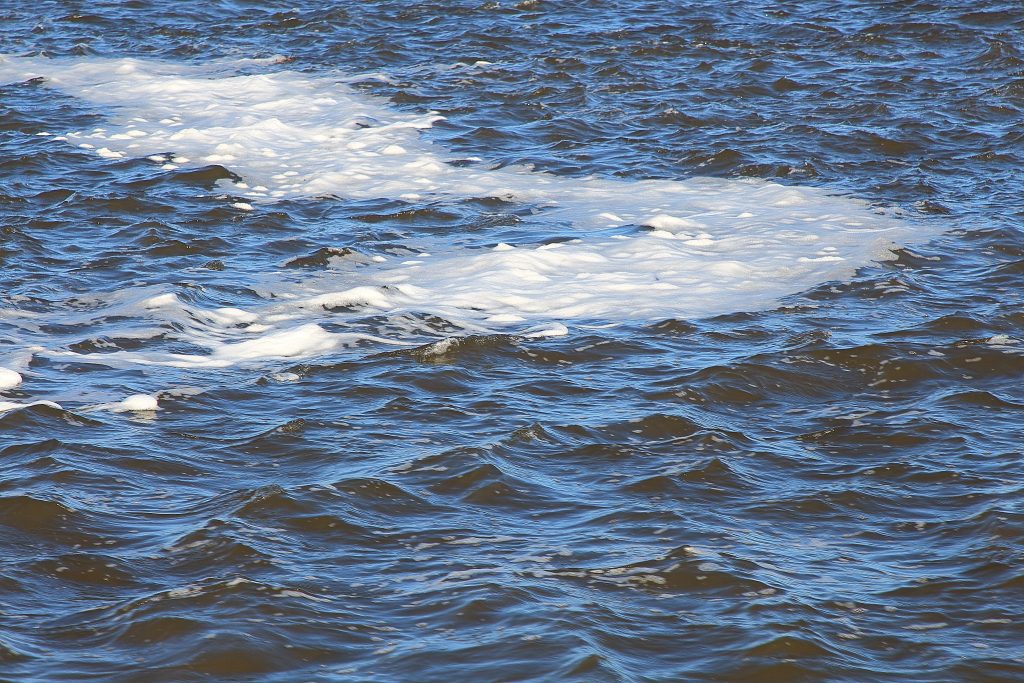A Thin White Line
November 6, 2024By Tom Poland
CUMBERLAND SOUND, Fernandina Beach, Florida (Nov. 1, 2024): The catamaran motors by pelicans perched upon piers. It passes monstrous, red-orange contraptions that could be the Martian craft from H.G. Wells’s The War of the Worlds. The big cargo containers you see on 18-wheelers? These towering machines stack them on ships with great precision.
Picking up speed, we cross a wavering white line of foam. It’s a curious thing, this white line. Just ahead sits Cumberland Island, which has long held me in its thrall. I have yet to step ashore, yet to see Dungeness ruins up close, but I will. Right now I see the island’s wild horses from afar. For now, though, my minds on the St. Marys River, a watery labyrinth that seems to wind through every marsh and island in sight.

Cumberland Sound’s interface where fresh and saltwater meet. Photo by Tom Poland
If I told you the St. Marys begins as a small stream called River Styx, I would not be lying. If I said the river rises from the western edge of Trail Ridge, relic of a barrier island and dune system that, too, is true. If I write that the St. Marys River loses its channel in the heart of the Okefenokee Swamp, I am not lying. If I told you the river forms Georgia’s southernmost boundary, I tell the truth. And were I to tell you it flows north at one juncture that too is true.
The Amelia and East Rivers join the St. Marys here. Three rivers wind, bend, and U-turn as they carve treelike patterns into coastal landscapes. Go to Google Earth and search for the meandering St. Marys River. It looks as if a giant oak sprang from the sea so its interlacing limbs could throw dendritic shadows onto islands and their green, now November-gold marshscapes. Man, machines, and marsh, what a combination.
—
It’s a blue-sky day, this first day in November. The wind feels good against my face, the sea-salt fragrance pleasing. Atlantic Ocean breakers roll afar as we skirt Amelia and Cumberland Islands. Too few shrimp trawlers. The majority gave up the ghost to imported shrimp. Here and there bottlenosed dolphins surface. They’re blessed. They get to eat fresh shrimp.
Stories live in and around this water world. JFK Jr. married Carolyn Bessette September 21, 1996, in Cumberland Island’s small, wood-framed First African Baptist Church. Not quite three years later Atlantic waters claimed Kennedy, his wife, and her sister. Their ashes were scattered in the Atlantic off Martha’s Vineyard. Fort Clinch overlooks the entrance to Cumberland Sound. The fort never saw combat. Kings Bay is the homeport for the Atlantic Fleet’s Ohio-class and Trident-class nuclear submarines. Just one of its submarines possess more destructive power than all of World War II’s bombs combined, Japan’s two atom bombs included. May they never see combat. Thomas and Lucy Carnegie built Dungeness Mansion in 1884. It burned in the 1950s. Now wild horses graze in sight of ruins that seem Romanesque to me.
For 13,000 years ancient people, the Timucuans, lived off St. Marys’ bounty. Then the centuries, they came and went. The wealthy built that luxurious retreat that shares its name with a crab and a headland on the coast of Kent, England. The nouveau riche’s mill piles up sawdust for Amazon’s cardboard boxes. What, I wonder, do the wild Spanish horses think of these sawdust piles (saw chips), relics of my youth? The Kings Bay Naval Submarine Base helps keep the peace in a world it can destroy. Heaven and Hell in one sleek machine slicing through the seas.
Through it all that wavering line of foam has long delineated where fresh water meets salt water. Brackish they call it. Men and wars and dreams and fires and airplanes and ships and horses have come and gone and will continue to come and go. The thin white line, however, keeps on keeping on, a constant in a chaotic world of change. Lighter fresh water rises up and over the denser salt water—evidence and assurance that the water cycle is alive and well, warranty that rain will continue to fall from the vault we call the sky. That zigzagging line of foam, it’s proof that nature, so far, outlives man’s dreams, schemes, constructions, and destruction. Long may it run.
Georgia native Tom Poland writes a weekly column about the South, its people, traditions, lifestyle, and culture and speaks frequently to groups in the South. Governor Henry McMaster conferred the Order of the Palmetto upon Tom, South Carolina’s highest civilian honor, stating, “His work is exceptional to the state.” Poland’s work appears in books, magazines, journals, and newspapers throughout the South.
Visit Tom’s website at www.tompoland.net
Email him at [email protected]




















